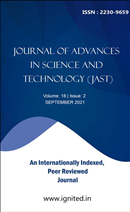A Study of Real and Unipolar Orthogonal Frequency Division Multiplexing for Optical Fiber Channel
Enhancing Spectral Efficiency and Tolerance for Polarization Mode Dispersion using OFDM in Optical Fiber Channel
Keywords:
Orthogonal frequency division multiplexing, Optical fiber channel, Telecommunications standards, Multi-carrier, Fourier Transform, IFFT orthogonal principle, ACO-OFDM, Subcarriers, Symbol length, Spectrum efficiency, Polarization mode dispersionAbstract
Orthogonal frequency division multiplexing (OFDM) is a widely used modulation andmultiplexing technology that has become an important part of telecommunications standards in manyareas of the world. The literature has also referred to OFDM as Multi-carrier and Fourier Transform, bothhistorically and now. OFDM is essentially the transmission of lower-rate data across multiple carriersusing the IFFT orthogonal principle to deliver a continuous series of data in parallel. To ensure thecarriers are mutually orthogonal, their frequency separation is carefully calibrated. Study discusses andcompares basic OFDM frame structures and input conditions for a real and unipolar OFDM signalgeneration and the study are also the discussed and explanation about the idea of time compression inACO-OFDM. Removal of subcarriers with zero value reduces the OFDM symbol length. Simulation resultsfor proposed time compressed ACO-OFDM and conventional ACO-OFDM are compared. Interest in usingorthogonal frequency division multiplexing (OFDM) in the optical domain for high-speed optical fibertransmission has grown in recent years owing to the technique's spectrum efficiency. Modern cable andwireless communications rely heavily on orthogonal frequency division multiplexing (OFDM). Opticalorthogonal frequency division multiplexing (OFDM) has been shown to be an effective method forsignificantly increasing spectral efficiency in a high-speed optical fiber line, all while increasingtolerance for polarization mode dispersion (PMD).Downloads
Download data is not yet available.
Published
2021-09-01
Issue
Section
Articles






